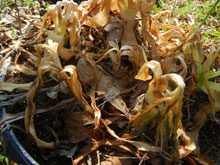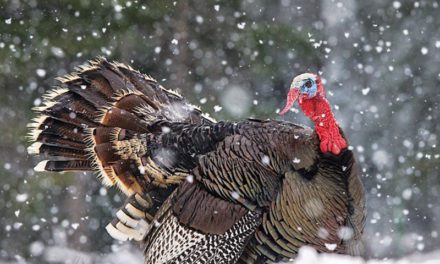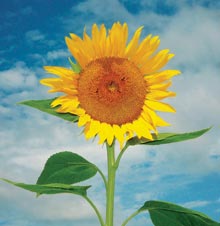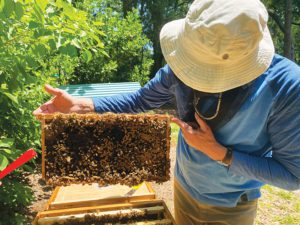
Rich Lucky removes a frame from his beehive for inspection. Photo by Tess Malijenovsky
The scent of smoking pine needles clouds Kelley and Rich Luikey, a pair of new beekeepers in Port Royal. It’s time to open the lid of their new honeybee hive. Joining them is Camp Arnold, of Beaufort Bees, who specializes in bee removals and beekeeping consultations. The Luikeys hope that Camp can help them locate and mark their queen bee. Without her everything falls apart.
As the lid comes off, honeybees rise from the wooden box in great numbers and the deep drone of their buzzing grows louder in the backyard. And yet, the bees don’t sting their barehanded visitors.
“The smoke helps mask their attack pheromones,” Camp explains. “And, it also simulates a natural forest fire, in which case they would gorge themselves with honey to leave the fire area and draw comb in a new location. In the process of filling their bellies and storing the honey, they get a little lethargic.”
Camp, who isn’t wearing any protective bee gear, handles the bees like docile flies while others whiz past his nose. He points out the males, called “drones,” the ones that don’t have stingers. They don’t gather nectar or pollen, and they rely on worker bees to be fed. Their only role is to mate with the queen. They are the not-so-busy bee of the colony.
Whereas thousands of sterile females, the “worker bees,” forage for pollen, make the honey, build the honeycomb, feed the drones, nurse the larvae, remove the dead, and defend the colony from invaders. They even regulate the temperature of the hive, says Greg Ferris, another local bee expert, the one Camps says taught him everything he knows.
“When it’s too hot out,” Greg explains to me later in the red barn of his apiary off U.S. 17, “the bees will go get water to bring back inside the hive and then use their wings to fan the air.” The evaporation has a cooling effect. And when the bees are too cold, Greg says, the bees cluster together to generate heat.
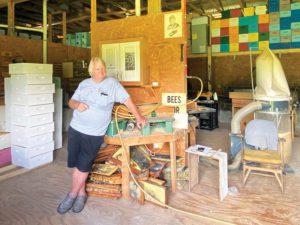
Greg Ferris of Ferris Apiaries in his workshop. By Tess Malijenovsky
Apitherapy
Greg doesn’t mind when he gets stung handling bees. “It’s good for ya,” he says. Along with selling starter hives, called “nucs” (for nucleus hive), Greg is one of the only people in the country who ships soapbox-sized wooden boxes of bees year-round for the explicit purpose of apitherapy—an alternative medicine using the venom of honeybee stings.
While apitherapy dates back thousands of years and Greg has firsthand accounts of its benefits, both personally and from customers, many claims are still not backed by scientific evidence. However, emerging research is beginning to prove several medicinal properties.
According to a study on bee venom published by the National Center for Biotechnology Information (NCBI), low doses of bee venom have the potential to help treat issues related to the inflammation of the skin, joints, and liver, and central nervous system diseases, such as Parkinson’s, Alzheimer’s, and ALS. According to this study, bee venom also shows promising benefits against different types of cancer as well as anti-viral activity, even for HIV.
Be warned, however, some people can have allergic reactions to bee stings that cause death. It’s considered the neighborly thing to do to make sure your neighbor’s not one of them before making the decision to start a beehive.
Things to know before getting into beekeeping
For the Luikeys, getting into beekeeping has been a fun new project that’s emerged from Covid, and they look forward to reaping the rewards of their own delicious honey in a year or maybe two. Having pollinators on site by their garden is a plus, too. But Kelley and Rich both agree, it’s been more of a commitment than originally anticipated.

Camp Arnold of Beaufort Bees rescuing the Luikeys’ beehive from a beetle invasion. Photo by Kelley Luicky
“When we originally decided to do the bees, I figured that they would be work but I actually did not anticipate how complex it all is and how many different ways of doing things there are,” says Kelley.
Also, she says, “Having some sort of local mentor that you can consult with is invaluable.” Weeks after the search for the queen, Kelley and Rich had a stressful inspection of one of their two beehives in which a couple frames broke. Despite repairs, the honey and brood of baby bees were broken, leaving the hive vulnerable to beetles.
“I called Camp after several days of sensing things were wrong with one of the colonies because the bees just weren’t settling down the way the other ones did,” Kelley says. “After lots of googling and trying to piece together what was wrong on my own, I was coming up short. Nothing matched the situation that we were seeing.
“Once I called Camp, he was able to take a guess as to what might have happened on the phone and came by the next day to help us take a look. He was correct in his insights, and while we weren’t able to save the honey and brood, we were able to save all of the bees.”
According to Camp, mistakes are a part of the learning process. “I always tell people you’re going to make mistakes and you just learn from them. Every hive is different—they all have different temperaments.”
It can take multiple seasons to learn how to read the behavior of bees. In the beginning, new beekeepers may get into their hives too much or too little or run into pests—the range of things that can go wrong are broad. Mostly, Camp thinks, people just get too anxious.
“They don’t want to kill their bees,” he says, “so they go on YouTube and they watch a hundred different videos, and everyone does it differently. They get overwhelmed and forget that these are wild animals that have been here for a long time. They know what’s best, so just let them be.”
What equipment do you need to start a beehive? And how much does it cost?
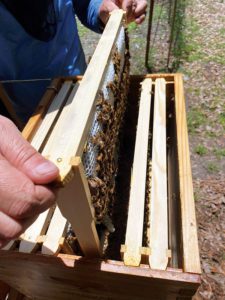
Rich Luiky removes a frame from his beehive. By Tess Maliijenovsky
To get started, you’ll need a beehive. There are many varieties of beehives, but the most common style in modern beekeeping is a Langstroth hive with 10 frames. If you want to stay local, Greg Ferris and Camp Arnold sell complete beginner hive kits, which includes one queen, a five-frame nuc, five empty frames, a deep box, inner cover, lid, and bottom screened door for around $285. Separately, you can buy a nuc for $165 (prices fluctuate).
Here are some common add-ons:
- Bee smoker ($20)
- Bee tool ($10)
- Bee feeder ($10-$30)
- Queen excluder ($20)
- Safety suit and helmet ($50-$150)
Naturally, there is a large price range, from do-it-yourself beehives to spendy pre-made kits.
How much work is it to keep bees?
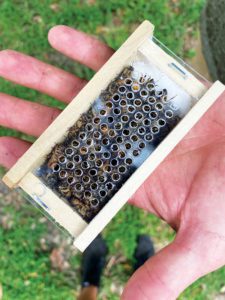
A box of 60-80 bees ready to be shipped for the medicinal use of honeybee venom. Studies are beginning to prove its effectiveness in reducing skin, joint, liver inflammation and treating central nervous diseases, like Parkinson’s, Alzheimer’s, and ALS. By Tess Malijenovsky
It depends on what you want out of your bees. If you’re after the honey, it’s recommended to inspect your hive once every week or two during the summer. In the winter, bees are less active and require much less monitoring.
The plight of bees
Bee and other pollinator populations are declining rapidly worldwide. With more than two-thirds of the world’s agricultural crops depending on pollination, the decline of pollinators threatens to destabilize the world’s ability to produce food.
According to Xerces Society for Invertebrates, the economic value of native pollinators in the U.S. alone is estimated at $3 billion per year. Xerces reports that “habitat loss, alteration, and fragmentation, as well as diseases, pesticide use, and climate change are all threats to pollinators and the ecosystems that they support.”
When landscaping, consider planting native plants that pollinators love. Beaufort County Cooperative Extension is a good resource for a list (843-470-5109).
Honeybees are just one group of bee species. In the U.S., there are roughly 3,600 bee species, 90 percent of which lead solitary lives rather than relying on social colonies. Worldwide there are an estimated 20,000 bee species.
Local beekeepers and honey
Camp Arnold, Beaufort Bees | 904-803-4079
Greg Ferris, Ferris Apiaries | 1-800-787-4669 | 807 Kings Hwy, Yemassee, SC 29945
Jan and Will Brown, Mrs. B Honey | 843-441-1122


